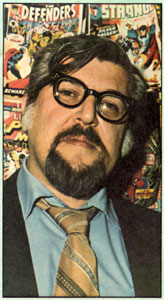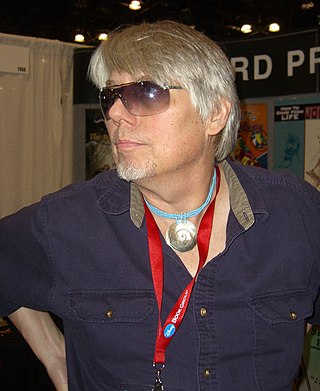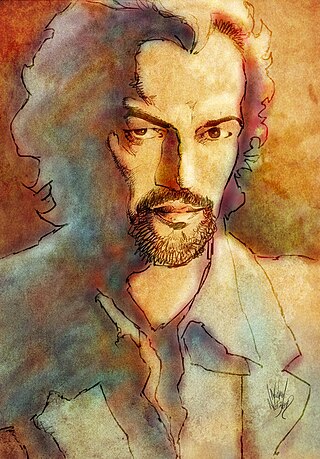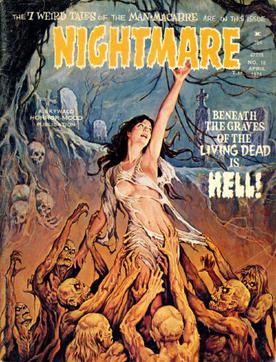A graphic novel is a long-form work of sequential art. The term graphic novel is often applied broadly, including fiction, non-fiction, and anthologized work, though this practice is highly contested by comics scholars and industry professionals. It is, at least in the United States, typically distinct from the term comic book, which is generally used for comics periodicals and trade paperbacks.

Fantagraphics is an American publisher of alternative comics, classic comic strip anthologies, manga, magazines, graphic novels, and (formerly) the erotic Eros Comix imprint.

Daniel Gillespie Clowes is an American cartoonist, graphic novelist, illustrator, and screenwriter. Most of Clowes's work first appeared in Eightball, a solo anthology comic book series. An Eightball issue typically contained several short pieces and a chapter of a longer narrative that was later collected and published as a graphic novel, such as Like a Velvet Glove Cast in Iron (1993), Ghost World (1997), David Boring (2000) and Patience (2016). Clowes's illustrations have appeared in The New Yorker, Newsweek, Vogue, The Village Voice, and elsewhere. With filmmaker Terry Zwigoff, Clowes adapted Ghost World into a 2001 film and another Eightball story into the 2006 film, Art School Confidential. Clowes's comics, graphic novels, and films have received numerous awards, including a Pen Award for Outstanding Work in Graphic Literature, over a dozen Harvey and Eisner Awards, and an Academy Award nomination.

John Buscema was an American comic book artist and one of the mainstays of Marvel Comics during its 1960s and 1970s ascendancy into an industry leader and its subsequent expansion to a major pop-culture conglomerate. His younger brother Sal Buscema is also a comic book artist.

Frank Brunner is an American comics artist and illustrator best known for his work at Marvel Comics in the 1970s.

Barry Windsor-Smith is a British comic book illustrator and painter whose best-known work has been produced in the United States. He attained note working on Marvel Comics' Conan the Barbarian from 1970 to 1973, and for his work on the character Wolverine, particularly the 1991 "Weapon X" story arc. His other noted Marvel work included a 1984 "Thing" story in Marvel Fanfare, the "Lifedeath" and "Lifedeath II" stories with writer Chris Claremont that focused on the de-powered Storm in The Uncanny X-Men, as well as the 1984 Machine Man limited series with Herb Trimpe and Tom DeFalco.

Gil Kane was a Latvian-born American comics artist whose career spanned the 1940s to the 1990s and virtually every major comics company and character.

Archie Goodwin was an American comic book writer, editor, and artist. He worked on a number of comic strips in addition to comic books, and is known for his Warren and Marvel Comics work. For Warren he was chief writer and editor of landmark horror anthology titles Creepy and Eerie between 1964 and 1967. At Marvel, he served as the company's editor-in-chief from 1976 to the end of 1977. In the 1980s, he edited the publisher's anthology magazine Epic Illustrated and its Epic Comics imprint. He is also known for his work on Star Wars in both comic books and newspaper strips. He is regularly cited as the "best-loved comic book editor, ever."
Warren Publishing was an American magazine company founded by James Warren, who published his first magazines in 1957 and continued in the business for decades. Magazines published by Warren include After Hours, Creepy, Eerie, Famous Monsters of Filmland, Help!, and Vampirella.

Axel Pressbutton is a fictional character appearing in comic books. A violent cyborg with the face of Ernest Borgnine, a button on his chest which delivers orgasmic pleasure when pressed, and a phobia about vegetation, he was created by Steve Moore and Alan Moore, under the pseudonym "Curt Vile".

Richard Bassford is an American illustrator who has worked in both advertising and comic books.

Skywald Publications was an American publisher of black-and-white comics magazines, primarily the horror anthologies Nightmare, Psycho, and Scream. It also published a small line of comic books and other genre magazines. Skywald's original comics were similar in appearance and quality to rival black-and-white publisher Warren Publishing, and even employed many of the same creators. Skywald operated from 1970 to 1975.

Blackmark is a paperback book published by the American company Bantam Books in January 1971. It is one of the first American graphic novels, predating works such as Richard Corben's Bloodstar (1976), Jim Steranko's Chandler: Red Tide (1976), Don McGregor and Paul Gulacy's Sabre, and Will Eisner's A Contract with God. It was conceived and drawn by comic book artist Gil Kane, and scripted by Archie Goodwin from an outline by Kane.
Star Hawks was a comic strip created by Ron Goulart and Gil Kane, first published on October 3, 1977, that ran through May 2, 1981. It was written through April 1979 by Goulart, followed by Archie Goodwin (1979-1980), Roger McKenzie (1980-1981) and Roger Stern. Comics veteran Gil Kane provided the artwork, with uncredited help from Ernie Colón and Howard Chaykin.
St. John Publications was an American publisher of magazines and comic books. During the 1947-1958 existence of its comic-book division, St. John established several industry firsts. Founded by Archer St. John, the firm was located in Manhattan at 545 Fifth Avenue. After the St. John comic books came to an end in 1958, the company continued to publish its magazine line into the next decade. Flying Eagle Publications was a magazine affiliate of St. John Publications. Comic book imprints included Approved Comics, Blue Ribbon, and Jubilee Publications.

Doomsday + 1 is an American post-apocalyptic comic-book series that was published by Charlton Comics in the 1970s.
William Bryan Dubay, also known by the pseudonyms Will Richardson, and Dube, was an American comic-book editor, writer and artist best known as editor and writer for Warren Publishing, including that company's horror-comics magazines Creepy, Eerie and Vampirella.

Blazing Combat was an American war-comics magazine published quarterly by Warren Publishing from 1965 to 1966. Written and edited by Archie Goodwin, with artwork by such industry notables as Gene Colan, Frank Frazetta, John Severin, Alex Toth, and Wally Wood, it featured war stories in both contemporary and period settings, unified by a humanistic theme of the personal costs of war, rather than by traditional men's-adventure motifs.
James Warren is a magazine publisher and founder of Warren Publishing. Magazines published by Warren include Famous Monsters of Filmland, the horror-comics magazines Creepy, Eerie, and Vampirella, the war anthology Blazing Combat, and the science-fiction anthology 1984, among others. Contributors to Warren’s magazines included such significant artists as Neal Adams, Richard Corben, Bernie Wrightson, Johnny Craig, Reed Crandall, Steve Ditko, Frank Frazetta, Russ Heath, Esteban Maroto, Alex Niño, Sanjulián, John Severin, Tom Sutton, Angelo Torres, Al Williamson, and Wally Wood, and writers/editors including Archie Goodwin, Louise Jones, Don McGregor, and Doug Moench. He appointed Billy Graham as the first known African-American art director in mainstream, nationally distributed comic books/comics magazines.














